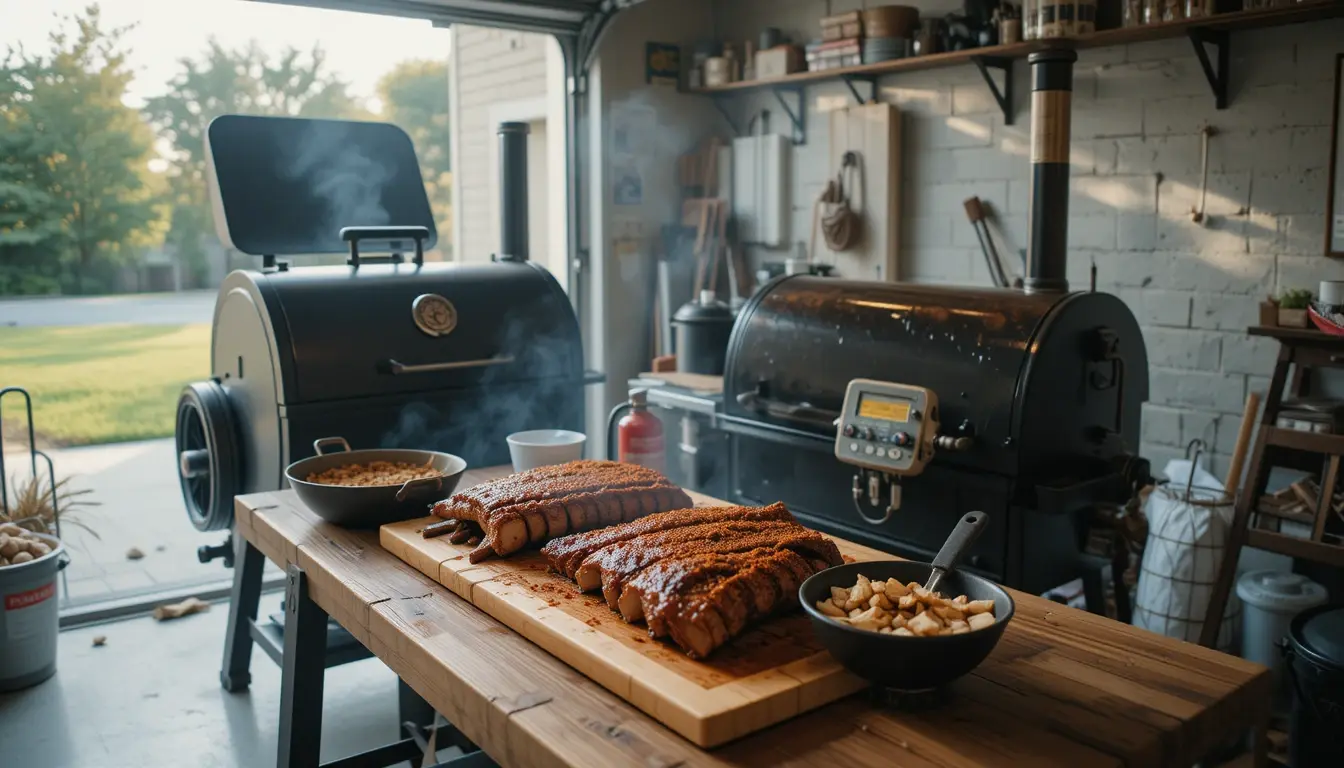Intriguing Question to Spark Curiosity
Have you ever wondered how professional chefs create those tender, smoky, and flavorful meats without spending thousands on fancy equipment? Believe it or not, you can achieve restaurant-quality smoked meats right in your garage! Let’s dive into the secrets of smoking meats at home and uncover how anyone can master this art with just a little know-how and some basic tools.
Overview: What Makes This Recipe Special?
Smoking meat in your garage is more than just cooking, it’s an experience. Whether you’re a beginner or a seasoned pitmaster, this method offers incredible results that are sure to impress family and friends. Here’s what makes this recipe stand out:
- Time Requirement : Depending on the type of meat and desired level of doneness, smoking times can range from 4 to 12 hours. Don’t worry; most of that time is hands-off!
- Difficulty Level : Medium. While smoking requires patience and attention to detail, the process itself is straightforward once you understand the basics.
- Why It’s Special : Smoking enhances flavor through slow cooking and infuses the meat with rich, aromatic smoke. Plus, it’s healthier because the low-and-slow technique breaks down tough fibers, making the meat easier to digest
So, let’s get started by gathering our essential ingredients!
Table of Contents
1: Key Benefits of “How to Smoke Meats In A Garage“
Smoking meats in your garage might sound unconventional, but it’s a game-changer for anyone looking to elevate their culinary skills without breaking the bank. Here’s why this method is worth trying:
- Enhanced Flavor : The slow-cooking process infuses your meats with deep, smoky flavors that are impossible to replicate with traditional grilling methods
- Healthier Cooking : Low-and-slow smoking breaks down tough fibers, making the meat more tender and easier to digest while preserving its natural juices
- Convenience at Home : With just a little setup, you can transform your garage into a professional-grade smoking station, eliminating the need for expensive equipment or outdoor space
- Versatility : From brisket to ribs, chicken thighs to turkey breasts, smoking opens up endless possibilities for experimenting with different cuts and flavors
Why This Method Stands Out
Imagine achieving restaurant-quality results right in your own backyard—or rather, your garage! By controlling variables like temperature, airflow, and smoke intensity, you gain mastery over the cooking process. Plus, the satisfaction of creating something so flavorful and impressive is unmatched.
Practical Tips for Success
Here are a few actionable insights to set you up for success:
- Ventilation Matters : Ensure your garage has proper airflow to prevent smoke buildup. A small fan or open door can make all the difference
- Start Simple : Begin with easy-to-smoke cuts like chicken thighs shoulders before moving on to more challenging meats like brisket.
- Invest in Quality Tools : While you don’t need top-of-the-line equipment, having a reliable thermometer and smoker will significantly improve your outcomes
By embracing these benefits and tips, you’ll be well on your way to crafting unforgettable meals that bring family and friends together. Ready to dive deeper? Let’s explore the ingredients next!
2: Ingredients for “How to Smoke Meats In A Garage“
Let’s dive into the essential ingredients that will help you achieve those incredible results. Think of this as your toolkit for creating mouthwatering, smoky flavors right in your garage. Here’s what you’ll need:
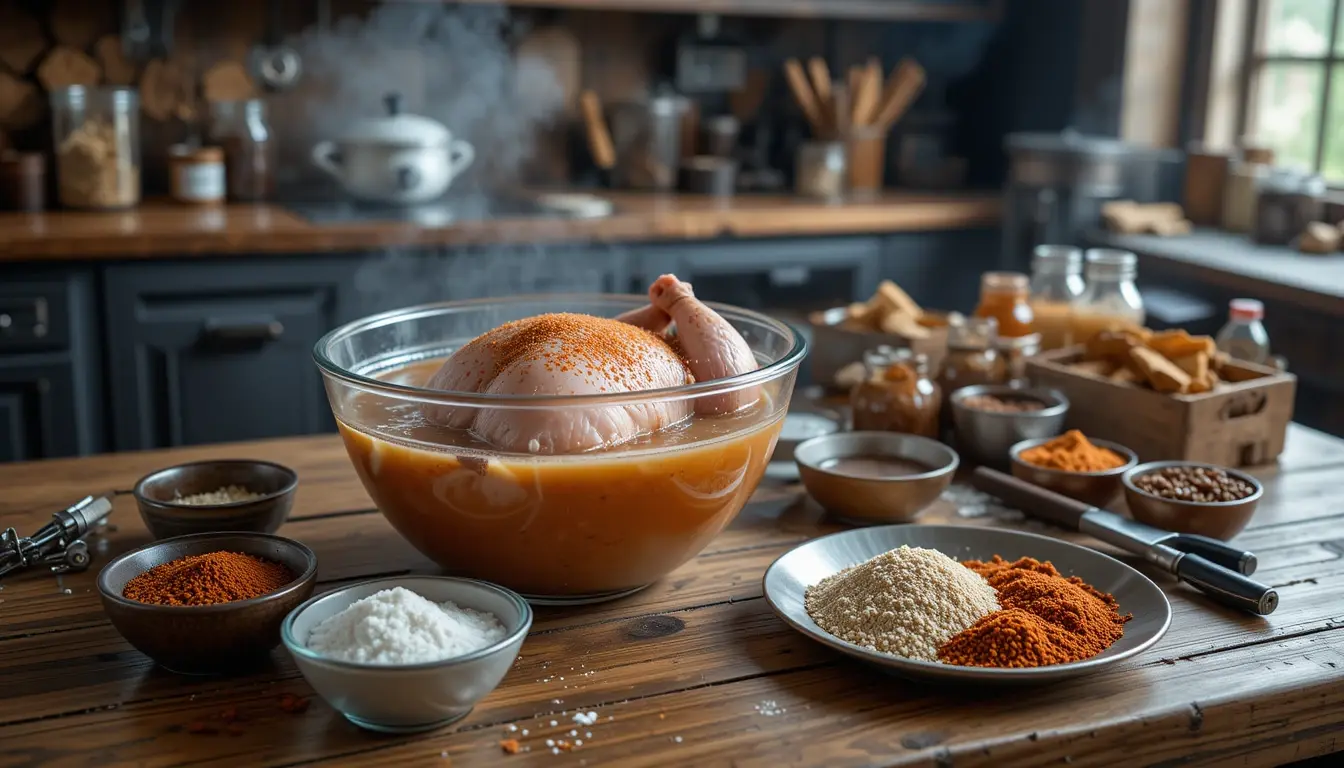
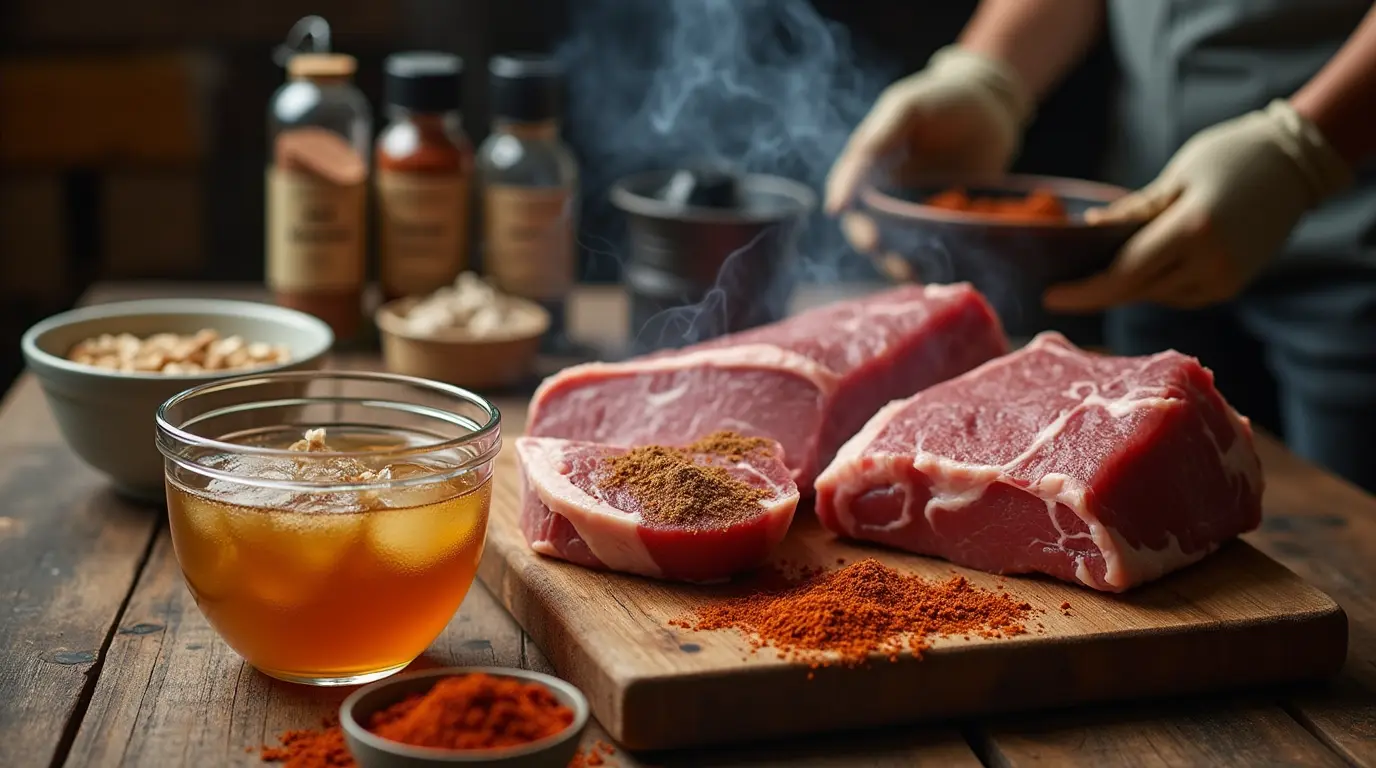
1. Brine (Optional but Recommended)
A brine is a simple solution that enhances moisture and flavor before smoking. It’s especially useful for leaner cuts like chicken or turkey.
- Ingredients :
- ¼ cup brown sugar
- ¼ cup salt
- 2 cups cold water
Why Use a Brine?
Brining helps retain moisture during the smoking process, ensuring your meat stays juicy and tender. Simply soak your meat in the brine for 4–8 hours, depending on its size
2. Dry Rub
The dry rub is where the magic happens! This blend of spices creates a flavorful crust (also known as “bark”) while infusing the meat with bold aromas.
- Basic Recipe :
- ¼ cup garlic powder
- ¼ cup onion powder
- 2 tablespoons paprika
- 1 tablespoon black pepper
- 1 teaspoon cayenne pepper (optional, for heat)
Pro Tip : Adjust the spice levels to suit your taste. For example, add more paprika for sweetness or extra cayenne for a kick
3. Wood Chips or Chunks
Choosing the right wood is crucial for achieving the perfect smoke flavor. Different woods pair beautifully with specific types of meat.
- Best Options :
- Hickory : Strong, bacon-like flavor perfect for beef
- Applewood : Mild and fruity great for poultry
- Cherry : Sweet, slightly fruity notes ideal for ribs and chicken
- Pecan : Nutty and rich works well with all meats
Soaking Tip : Soak your wood chips in water for 30 minutes before using them to produce thicker, longer-lasting smoke
4. Optional Additions
Feel free to experiment with these extras to elevate your dish further:
- Marinades : Combine vinegar, oil, herbs, and spices for an extra layer of flavor.
- Injectors : Use marinade injectors to push flavor deep into the meat.
- Cannabis-Infused Seasoning : If you’re feeling adventurous, try adding ground cannabis to your dry rub for a unique twist
Substitutions and Variations
Don’t have access to traditional wood chips? No problem! You can still create delicious smoked flavors by using alternatives like:
- Vinegar-based solutions
- Nitrates/nitrites for preservation
Remember, cooking is all about creativity, so feel free to adapt based on what’s available to you.
With these ingredients at hand, you’re ready to move on to the next step: preparing your smoker and getting started with the actual cooking process. Stay tuned for detailed instructions to guide you every step of the way!
3: Step-by-Step Instructions for “How to Smoke Meats In A Garage“
Now that you’ve gathered your ingredients and tools, it’s time to bring everything together. Follow these step-by-step instructions to ensure success every time you fire up your smoker.
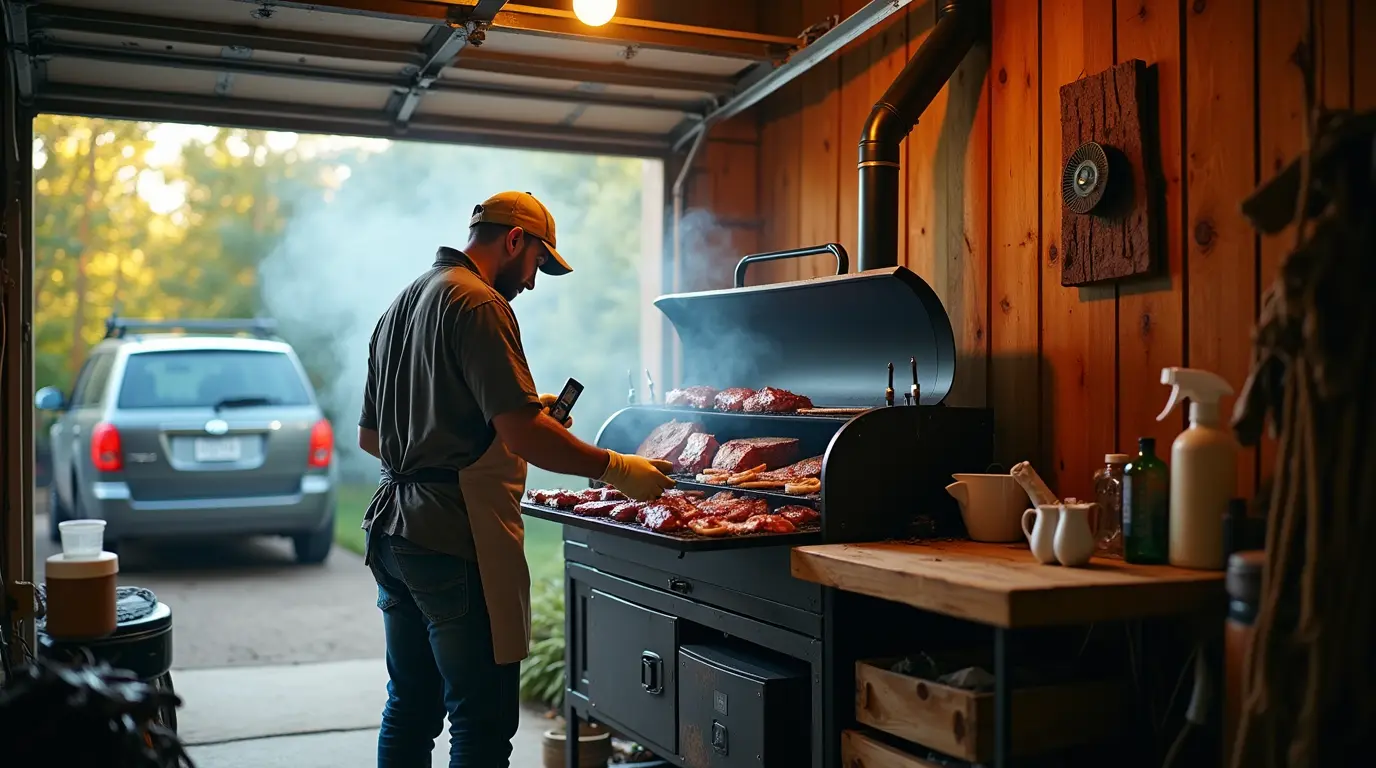
Step 1: Prepare Your Space
Before lighting the smoker, make sure your garage is ready:
- Clear out any flammable materials or clutter.
- Ensure proper ventilation by opening the garage door slightly or using a fan to direct smoke outside
- Place your smoker near an electrical outlet if needed, keeping safety in mind.
Step 2: Set Up Your Smoker
Setting up your smoker correctly is key to achieving consistent results:
- Light your coals according to the manufacturer’s instructions.
- Add soaked wood chips or chunks on top of the lit coals for aromatic smoke
- Adjust the vents to maintain a steady temperature between 225°F and 250°F
Pro Tip : Use a water pan inside the smoker to add moisture and prevent the meat from drying out during the long cooking process.
Step 3: Prep the Meat
Proper preparation ensures tender, flavorful results:
- Trim excess fat but leave enough to keep the meat moist.
- Apply your dry rub generously, ensuring every surface is coated. Let the meat sit for 30 minutes to allow the spices to penetrate.
- If brining, pat the meat dry before applying the rub to avoid diluting the flavors.
Step 4: Smoke the Meat
Once your smoker is prepped and your meat is ready, it’s time to start smoking:
- Place the meat fat-side up on the smoker rack.
- Monitor the internal temperature closely using a digital thermometer:
- Brisket: 203°F
- Beef shoulder: 195°F
- Chicken thighs: 165°F
- Ribs: 190°F
- Add more wood chips as needed to maintain a steady flow of smoke.
Important Note : Avoid opening the lid too often, as this can cause temperature fluctuations and extend cooking times
Step 5: Rest and Wrap
When the meat reaches its target temperature:
- Wrap it tightly in aluminum foil with a splash of juice or broth to lock in moisture
- Let it rest for at least 30–60 minutes to allow the juices to redistribute.
Common Mistakes to Avoid
Here are a few pitfalls to watch out for:
- Impatience : Cooking low-and-slow requires patience; rushing the process can ruin the texture and flavor
- Overusing Sauce : Resist the urge to douse your meat in sauce too early, as this can mask the natural smoky flavors
- Poor Fire Management : Ensure your fire burns cleanly to produce high-quality smoke that enhances rather than detracts from the taste
With these steps, you’re well on your way to mastering the art of smoking meats in your garage. Next, we’ll explore some pro tips and variations to take your skills to the next level!
4: Pro Tips and Variations for Smoking Meats in Your Garage
Now that you’ve mastered the basics, let’s take your smoking skills to the next level with these pro tips and creative variations. These insights will help you refine your technique and experiment with new flavors.
Pro Tips for Perfect Results
- Monitor Airflow Carefully : Proper airflow is essential for maintaining consistent smoke and temperature. If your garage lacks natural ventilation, consider using a small fan to direct smoke away from the smoker
- Don’t Overdo the Smoke : One common rookie mistake is thinking more smoke equals better flavor. In reality, too much smoke can overpower the meat, leaving it tasting bitter or acrid
- Stick to mild woods like applewood or cherry for a balanced flavor profile.
- Use Heavy-Duty Tools : Invest in sturdy tongs, meat forks, and heat-resistant gloves to handle large cuts safely. These tools make flipping, moving, and checking temperatures easier without risking burns
- Adjust for Weather Conditions : If you plan to smoke overnight or during inclement weather, be prepared for challenges like rain affecting your setup. Consider postponing long cooks if conditions aren’t ideal to avoid complications
- Rest Your Meat Properly : After smoking, give your meat time to rest. This allows the juices to redistribute, resulting in a juicier final product. Wrapping in foil or butcher paper can also help retain moisture during this phase
Creative Variations to Try
Once you’re comfortable with the basics, feel free to experiment with these exciting twists:
- International Spices : Incorporate global flavors by adding cumin, turmeric, or curry powder to your dry rub for a Middle Eastern or Indian-inspired twist.
- Cannabis-Infused Seasonings : For a unique touch, try infusing ground cannabis into your spice blend. This works particularly well with ribs or chicken thighs
- Alternative Woods : Venture beyond traditional hickory or mesquite by experimenting with less common options like peachwood, plumwood, or even walnut for distinct flavor notes
- Marinades and Injectors : Use marinade injectors to push flavor deep into the meat. A simple mixture of soy sauce, garlic, and brown sugar can elevate any cut
Troubleshooting Common Issues
Even seasoned pitmasters encounter hiccups now and then. Here’s how to tackle some common problems:
- Uneven Cooking : Rotate your meat halfway through the smoking process to ensure even exposure to heat and smoke.
- Dry Meat : Add a water pan inside the smoker to increase humidity levels, preventing the meat from drying out.
- Weak Flavor : Enhance the taste by extending the brining or marinating time before smoking.
By incorporating these pro tips and variations, you’ll not only improve your smoking technique but also keep things fresh and exciting every time you fire up your smoker. Next, we’ll explore serving suggestions to complete your culinary masterpiece!
5: Serving Suggestions for Your Smoked Meats
Now that your smoked meats are perfectly cooked, it’s time to think about how you’ll serve them. The right sides and garnishes can elevate your dish, turning a simple meal into an unforgettable experience. Here are some ideas to inspire you:
Classic Side Dishes
Pair your smoked meats with these timeless favorites for a crowd-pleasing spread:
- Coleslaw : A creamy or vinegar-based slaw complements the richness of smoked meats beautifully
- Baked Beans : Sweet and savory baked beans add a comforting touch to any barbecue feast
- Cornbread : Serve warm cornbread alongside your meats for a classic Southern pairing
Creative Accompaniments
Why stick to tradition when you can get creative? Try these unique side dishes to impress your guests:
- Smoked Onion Slaw : Add smoky depth to your coleslaw by smoking the onions first
- Mexican Corn (Elotes) : Grilled or smoked corn coated in a spicy cheese sauce is a vibrant and flavorful option
- Maple-Smoked Stuffed Jalapeños : For a bit of heat, try jalapeños stuffed with cream cheese, smoked until golden and gooey
Garnishes and Sauces
Don’t forget to finish your dish with the perfect garnish or sauce:
- Fresh Herbs : Sprinkle chopped parsley, cilantro, or thyme over your plated meats for a pop of color and freshness.
- Barbecue Sauce : Offer a variety of sauces, from tangy Carolina-style vinegar-based options to rich, tomato-based Kansas City styles
- Drizzles and Glazes : Honey, maple syrup, or a balsamic reduction can add sweetness and shine to your presentation.
Presentation Tips
How you present your food matters just as much as how it tastes. Follow these tips for a polished look:
- Use large platters or wooden boards to display your smoked meats, creating a rustic aesthetic.
- Arrange sides around the main dish in an appealing manner, ensuring there’s enough space between each item.
- Garnish generously but thoughtfully too many toppings can overwhelm the plate.
By combining delicious sides, thoughtful garnishes, and attractive presentations, you’ll create a dining experience that’s both memorable and satisfying. Next, we’ll wrap up with some final thoughts to encourage your continued culinary journey!
6: Conclusion – Your Journey to Mastering “How to Smoke Meats In A Garage”
Congratulations! You’ve now explored everything from setting up your smoker to serving up delicious, restaurant-quality smoked meats right in your garage. Whether you’re a beginner or an experienced pitmaster, this journey is all about practice, patience, and passion for creating unforgettable flavors.
Why Keep Experimenting?
The beauty of smoking meats lies in its versatility. Every time you fire up your smoker, it’s an opportunity to refine your technique and try something new. Don’t be afraid to experiment with different woods, spices, and cuts of meat
Remember, even professional chefs started somewhere and so can you!
A Few Final Tips to Inspire You
- Stay Curious : Explore international cuisines by incorporating unique spices like cumin, turmeric, or garam masala into your dry rubs
- Invest in Quality Tools : While basic equipment will get you started, upgrading to features like temperature probes or combo grills can enhance your experience
- Share Your Creations : Cooking is more enjoyable when shared. Invite friends over for a tasting session or post your results online to inspire others
Embrace the Process
Smoking meats isn’t just about the end result, it’s about the joy of learning and connecting with food on a deeper level. With each attempt, you’ll gain confidence and discover new ways to elevate your dishes. So keep practicing, stay inspired, and most importantly, have fun!
Ready to take your skills further? Dive into our FAQs section below for answers to common questions and troubleshooting advice. Happy smoking, and may every meal bring warmth and delight to your table!
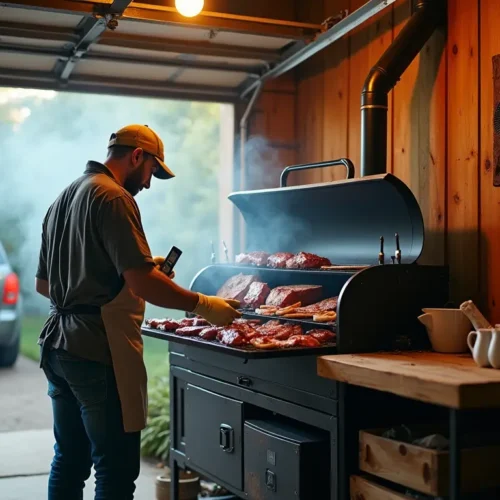
How to Smoke Meats In A Garage
Ingredients
Brine (Optional but Recommended)
- A brine is a simple solution that enhances moisture and flavor before smoking. It’s especially useful for leaner cuts like chicken or turkey.
Ingredients :
- ¼ cup brown sugar
- ¼ cup salt
- 2 cups cold water
Why Use a Brine?
- Brining helps retain moisture during the smoking process ensuring your meat stays juicy and tender. Simply soak your meat in the brine for 4–8 hours, depending on its size
Dry Rub
- The dry rub is where the magic happens! This blend of spices creates a flavorful crust also known as “bark” while infusing the meat with bold aromas.
Basic Recipe :
- ¼ cup garlic powder
- ¼ cup onion powder
- 2 tablespoons paprika
- 1 tablespoon black pepper
- 1 teaspoon cayenne pepper optional, for heat
Pro Tip : Adjust the spice levels to suit your taste. For example, add more paprika for sweetness or extra cayenne for a kick
Wood Chips or Chunks
- Choosing the right wood is crucial for achieving the perfect smoke flavor. Different woods pair beautifully with specific types of meat.
Best Options :
- Hickory : Strong bacon-like flavor perfect for beef
- Applewood : Mild and fruity great for poultry
- Cherry : Sweet slightly fruity notes ideal for ribs and chicken
- Pecan : Nutty and rich works well with all meats
- Soaking Tip : Soak your wood chips in water for 30 minutes before using them to produce thicker longer-lasting smoke
Optional Additions
- Feel free to experiment with these extras to elevate your dish further:
- Marinades : Combine vinegar oil, herbs, and spices for an extra layer of flavor.
- Injectors : Use marinade injectors to push flavor deep into the meat.
- Cannabis-Infused Seasoning : If you’re feeling adventurous try adding ground cannabis to your dry rub for a unique twist
Instructions
Step 1: Prepare Your Space
- Before lighting the smoker, make sure your garage is ready:
- Clear out any flammable materials or clutter.
- Ensure proper ventilation by opening the garage door slightly or using a fan to direct smoke outside
- Place your smoker near an electrical outlet if needed, keeping safety in mind.
Step 2: Set Up Your Smoker
- Setting up your smoker correctly is key to achieving consistent results:
- Light your coals according to the manufacturer’s instructions.
- Add soaked wood chips or chunks on top of the lit coals for aromatic smoke
- Adjust the vents to maintain a steady temperature between 225°F and 250°F
- Pro Tip : Use a water pan inside the smoker to add moisture and prevent the meat from drying out during the long cooking process.
Step 3: Prep the Meat
- Proper preparation ensures tender, flavorful results:
- Trim excess fat but leave enough to keep the meat moist.
- Apply your dry rub generously, ensuring every surface is coated. Let the meat sit for 30 minutes to allow the spices to penetrate.
- If brining, pat the meat dry before applying the rub to avoid diluting the flavors.
Step 4: Smoke the Meat
- Once your smoker is prepped and your meat is ready, it’s time to start smoking:
- Place the meat fat-side up on the smoker rack.
- Monitor the internal temperature closely using a digital thermometer:
- Brisket: 203°F
- Pork shoulder: 195°F
- Chicken thighs: 165°F
- Ribs: 190°F
- Add more wood chips as needed to maintain a steady flow of smoke.
- Important Note : Avoid opening the lid too often, as this can cause temperature fluctuations and extend cooking times
Step 5: Rest and Wrap
- When the meat reaches its target temperature:
- Wrap it tightly in aluminum foil with a splash of juice or broth to lock in moisture
- Let it rest for at least 30–60 minutes to allow the juices to redistribute.
Notes
Nutrition Information (Per Serving)
- Calories: 450 kcal
- Fat: 30g
- Saturated Fat: 10g
- Protein: 35g
- Carbohydrates: 5g
- Fiber: 0g
- Sugar: 2g
- Sodium: 600mg
Why This Recipe Stands Out
Smoking brisket in your garage is not only a rewarding experience but also an excellent way to achieve restaurant-quality results at home. With proper preparation and attention to detail, you can create tender, flavorful meat that will impress family and friends alike This recipe combines easy-to-follow steps with actionable tips, ensuring even beginners can master the art of smoking meats. Whether you’re hosting a backyard barbecue or simply looking to elevate your cooking skills, this dish promises satisfaction and flavor in every bite.7: FAQs – Your Burning Questions About “How to Smoke Meats In A Garage“
Let’s address some of the most common questions that arise when it comes to smoking meats in your garage. Whether you’re a beginner or looking to refine your technique, these answers will help guide you every step of the way.
Q1: Can I smoke meat without wood chips?
Absolutely! While traditional smoking relies on wood chips for flavor, there are alternatives if you don’t have access to them. For instance, you can use vinegar-based solutions, nitrates/nitrites, or even dry rubs to mimic smoky flavors
However, using actual wood chips remains the best option for authentic taste.
Q2: Is it safe to use a smoker in my garage?
Yes, but only with proper precautions. Ensure your garage has adequate ventilation open doors or windows and consider using a fan to direct smoke outside
Avoid sealing off the space completely, as this could lead to dangerous carbon monoxide buildup. Safety first!
Q3: How long should I rest the meat after smoking?
Resting is crucial for retaining moisture and allowing juices to redistribute. Aim for at least 30–60 minutes, depending on the size of the cut. Wrapping the meat in foil or butcher paper during this time can enhance tenderness
Q4: What are the best woods for smoking different types of meat?
Choosing the right wood depends on the type of meat and desired flavor profile:
- Beef Brisket : Hickory or mesquite for bold, robust flavors
- Chicken : Pecan or alder for balanced, subtle smokiness
Experiment with combinations to find what works best for your palate!
Q5: Why does my smoked meat turn out dry?
Dryness often results from overcooking or insufficient moisture during the process. To prevent this:
- Maintain consistent temperatures between 225°F and 250°F
- Use a water pan inside the smoker to add humidity
- Baste the meat periodically with marinades or mop sauces to keep it juicy.
Q6: Do I need special equipment to smoke meat in my garage?
Not necessarily, though having the right tools makes the job easier. At minimum, you’ll need:
- A smoker or charcoal grill with a lid
- Digital thermometer for precise temperature control
- Tongs, gloves, and other heat-resistant utensils for safe handling.
If budget allows, investing in a combo pellet/gas grill offers versatility for various cooking methods
Q7: Can I make BBQ sauce while smoking the meat?
Definitely! Making homemade BBQ sauce adds an extra layer of personalization to your meal. Try combining ingredients like Coke, honey, caramelized onions, garlic, black pepper, and Worcestershire sauce for a rich, tangy glaze
Q8: How do I know when the meat is done?
Internal temperature is key. Use a digital probe thermometer to check:
- Brisket : 203°F
- Beef Shoulder/Ribs : 195°F–205°F
- Chicken/Turkey : 165°F
Always refer to trusted guidelines for specific cuts
By addressing these frequently asked questions, we hope to empower you with confidence and clarity as you embark on your smoking adventures. Remember, practice makes perfect and every batch brings you closer to mastering the art of smoked meats in your garage!

